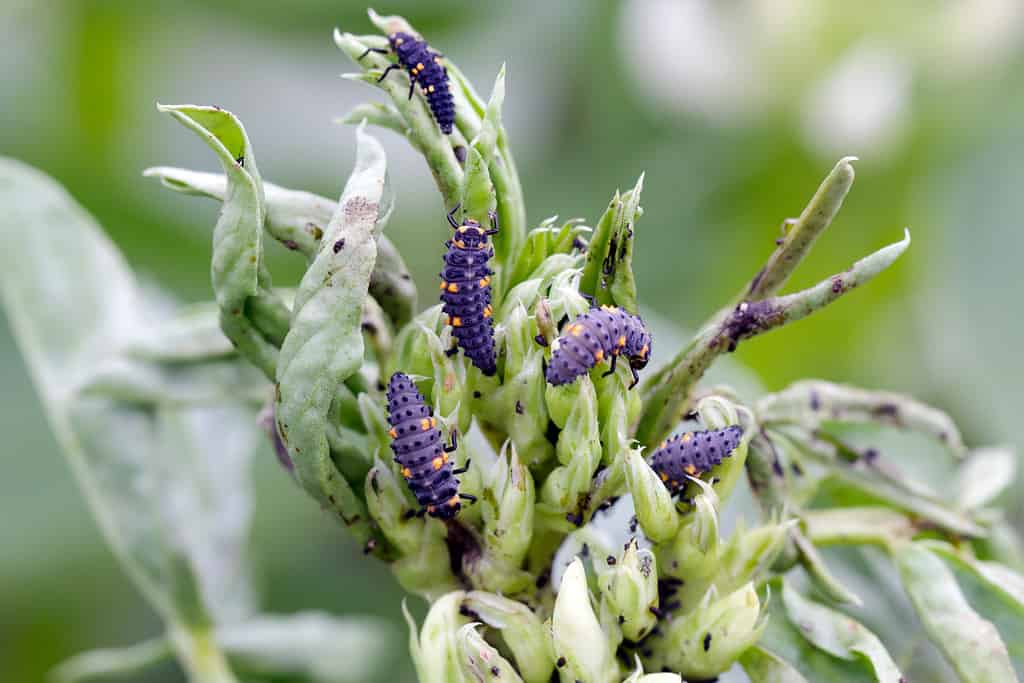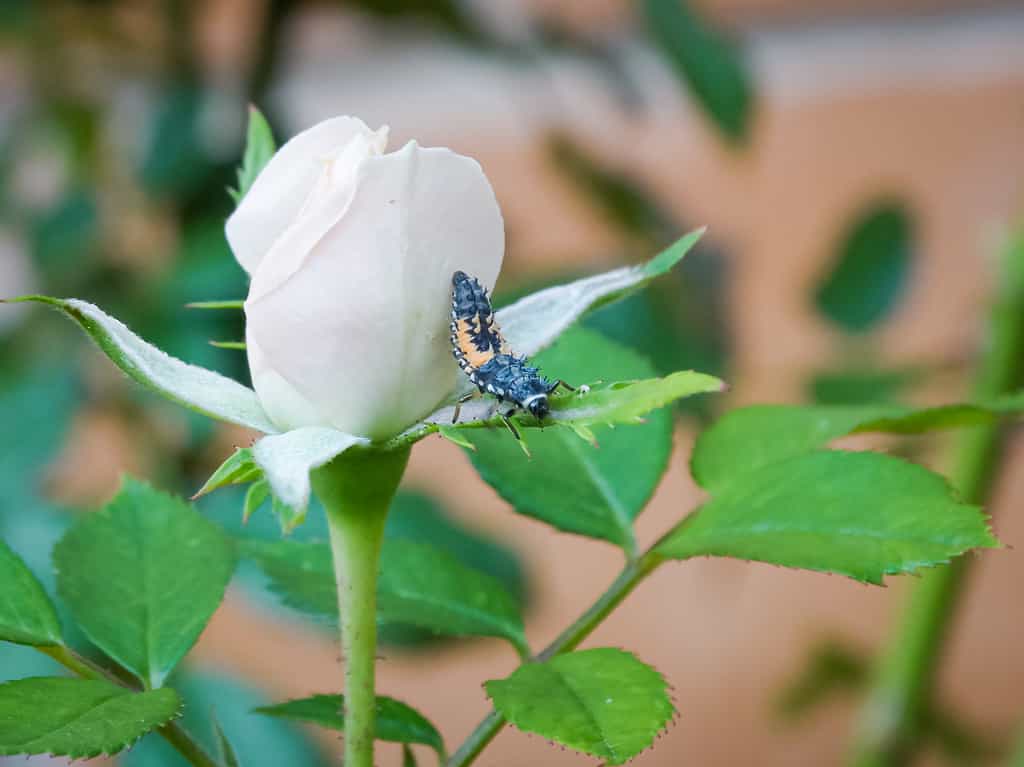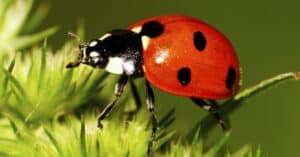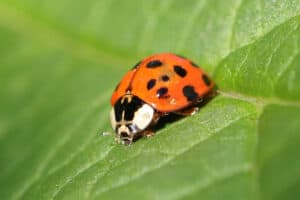Ladybugs are some of the most beloved and recognizable insects in the entire world. Their bright colors and gentle presence make them irresistible to young and old alike. Also known as lady beetles and ladybirds, ladybugs aren’t just pretty garden visitors — they are also superb pest controllers! Ladybugs devour aphids and other pests that often munch on plants. But have you ever seen a baby ladybug? These intriguing youngsters look nothing like their adult counterparts! In this article, we’ll take a closer look at some amazing baby ladybug pictures and learn many fascinating facts about these tiny creatures.
1. Baby Ladybugs Are Called Larvae

Ladybug larvae are small, growing only 3/8 to 1/2 of an inch long.
©Christiana Fletcher/iStock via Getty Images
When the weather warms up in the spring, ladybugs begin to emerge. They mate throughout the spring and summer, after which female ladybugs seek out safe havens to lay their eggs. They typically choose areas with plenty to eat and carefully lay their eggs on the underside of leaves to shield them from the elements and predators. Ladybugs create clusters of eggs, ranging from 10 to 50 — in fact, a female ladybug can lay as many as 1,000 eggs in a single season! Once the eggs hatch, baby ladybugs or larvae emerge.
2. Baby Ladybugs Look like Tiny Alligators

Although they may look a bit scary, ladybug larvae are completely harmless to humans.
©Navid Linnemann/iStock via Getty Images
Adult ladybugs are quite cute, but baby ladybugs don’t look anything like them! Instead, baby ladybugs or larvae look more like fearsome tiny alligators! They have long bodies, spiky legs, prickly skin, and a bumpy exoskeleton. Baby ladybug larvae usually grow about 3/8 to 1/2 of an inch long. Their six tiny legs are short and stout, but they pack a punch with sharp claws that help them cling to plants and other surfaces.
Baby ladybugs come in all different colors and patterns — some even change colors as they grow! One of the most recognizable ladybugs, the seven-spot ladybug (Coccinella septempunctata), starts as a larva with a long black body with three or four pairs of yellow or orange markings. Baby harlequin ladybugs, on the other hand, are black or dark gray with fearsome black and vibrant orange spines. Baby kidney spot ladybugs have dark spiky bodies covered with long bristles. And baby orange ladybugs are a dark creamy color with bright yellow streaks and black spots.
3. There Are about 5,000 Different Species of Ladybugs in the World

Adult ladybugs and larvae don’t look anything alike!
©i-am-helen/iStock via Getty Images
In pop culture, ladybugs are usually depicted as adorable tiny red beetles with perfectly round black spots. In reality, however, there are around 5,000 different ladybug species that come in a wide range of different colors and patterns — and some even have stripes instead of spots!
One of the most recognizable is the seven-spot ladybug or seven-spot ladybird, which is common throughout Europe. Seven-spot ladybugs have vibrant red exteriors, with seven distinctive black spots and a large black head. However, the convergent ladybug (Hippodamia convergens) in North America has a bright red or orange exterior with 12 spots. Harlequin ladybugs (Harmonia axyridis) come in all sorts of colors, from red or orange with black spots to black with red spots. The number of spots also varies; some harlequin ladybugs don’t have any spots at all, while others can have up to 22 spots.
Of course, not all ladybugs have spots. Like its name, the striped ladybug (Paranaemia vittigera) has stripes rather than spots. Native to North America and Canada, these colorful ladybugs come in red, orange, or yellow, with bold black bands on their backs.
4. Baby Ladybugs Go Through Four Stages of Metamorphosis Before They Become Adults

Pupae can only move their heads.
©Ika E Schroeder/iStock via Getty Images
Ladybugs undergo four distinct developmental stages: egg, larva, pupa, and adult. They start out in small yellow eggs and hatch into alligator-like larvae. Ladybug larvae then undergo four instars or stages over the next two to four weeks, molting or shedding their skin between each instar. When the time comes, the larva attaches itself to a leaf or other surface and transforms into the iconic adult ladybug we know and love.
5. Baby Ladybugs Have Ginormous Appetites

Ladybug larvae are voracious eaters.
©Tomasz Klejdysz/iStock via Getty Images
Transforming from a baby ladybug into an adult is a painstaking process and requires a lot of energy. This is why baby ladybugs have ginormous appetites. Baby ladybugs stay in the larva stage for two to four weeks. They eat as much as they possibly can and typically spend each and every day gobbling up anything they can find.
Their favorite food is aphids. A single baby ladybug can eat about 400 aphids before it pupates! In addition to aphids, baby ladybugs will also eat soft-bodied creatures like spider mites, thrips, scale insects, and white fly pupae. The only exception to this is the sub-family Epilachninae — these unique ladybugs are actually vegetarians!
6. Some Baby Ladybugs Are Cannibals

Gardeners and farmers love most ladybug species since both adults and babies eat aphids and other pests.
©Tatiany Kazmierczak/iStock via Getty Images
Baby ladybugs have enormous appetites, and some are so hungry that they will even resort to cannibalism. After emerging from their eggs, ladybug larvae will consume other unhatched ladybug eggs nearby. This actually helps them to develop much faster than other baby ladybugs that do not eat their siblings. By cannibalizing their siblings’ eggs, the ladybug larvae grow faster and have fewer competitors.
In fact, in one study researchers found that cannibalistic ladybug larvae reach adulthood 1.65 days earlier than those who didn’t engage in cannibalism. They also had a higher chance of surviving, with over 80% making it to the pupal stage compared to 46% of non-cannibalistic larvae. Some ladybug species even lay extra empty eggs alongside their fertile eggs so their babies have plenty to eat when they hatch.
The photo featured at the top of this post is © Christiana Fletcher/iStock via Getty Images
Thank you for reading! Have some feedback for us? Contact the AZ Animals editorial team.







